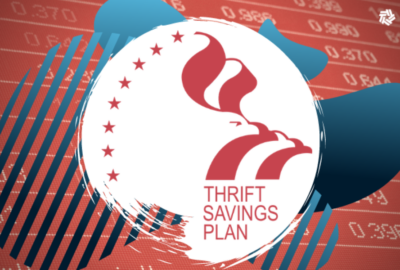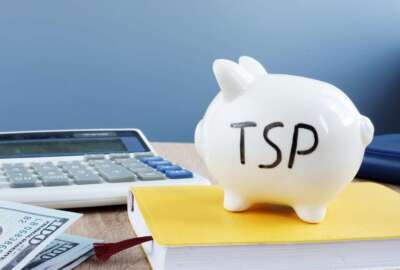Stock market returns got an F lately. Maybe the F Fund is the answer
The stock market is nothing if not exciting. If you have a Thrift Savings Plan account, such an opportunity might be the F Fund.
The stock market is nothing if not exciting. Even in the swoons, savvy investors find opportunity. If you have a Thrift Savings Plan account, such an opportunity might be the F Fund. Certified financial planner Art Stein of Arthur Stein Financial joined the Federal Drive with Tom Temin to share his analysis.
Interview transcript:
Tom Temin: And sort of bouncing around now the stock market, it reminded us what it’s capable of in recent weeks, which is not always going up. So, what’s your thinking here Art?
Art Stein: Well, my thinking is that when it comes to bond investment, TSP investors only have two choices. They have the G Fund and the F Fund. And the G Fund is really more of a savings account with a great interest rate. And I say that because it does not fluctuate in value the way even a short-term bond fund would. And because it’s guaranteed by the government, you know that price, the value is guaranteed by the government. The F Fund is actually just a typical Bond Index Fund. The index that follows is the Bloomberg Barclays intermediate-term bond index and that is actually the most commonly used bond index. You know, there are lots of funds outside of the TSP that use that same index have the same returns. Now, historically, most TSP investors ignored the F Fund. They put far more in the G Fund than the F Fund. I mean, far more, maybe six times as much. And you know, it’s really only recently that there’s more invested in the C Fund than the G Fund. For a long time, it was by far the most popular fund, and this was aggravated by the huge decline in bond values that we saw at the end of 21 and throughout 2022. The Fed was raising interest rates that causes prices of existing bonds to decline. And that meant in 2021, the F Fund was down 1.5% and in 2022, it was down 13%, which is just a big number for a bond fund. And it threw off all the statistics as to, you know, average return over the last 1, 3, 5, and 10 years. And so basically, the F Fund is outperforming G over the last 15 years average and over the last one year, but three, five and 10, G still outperforms. But that’s not normal, and there’s no reason to think that would increase. And what struck me was I was reading because I lead a very exciting life, the board minutes from Federal Retirement Thrift Investment Board, and they had commissioned a study of the L Funds and the best allocation for the L Fund.
Tom Temin: Sure.
Art Stein: And they were asked about, you know, G versus F. And what they found was that 100% allocation of the F Fund would do better than 100% allocation to the G Fund for the bond sleeve in the L Funds. Of course, when you look at the L Funds, they have way more in G than F.
Tom Temin: What about the notion, and I’ve heard this has been kind of turned on its ear in recent years, that the bond market is a good counter cyclical in terms of performance to the stock market. But that doesn’t always hold so much anymore, does it?
Art Stein: Well, it’s never always held. It doesn’t. You know, that’s true most years when there’s a stock market decline that bonds tend to hold up. They tend not to have a negative rate of return. They might have very low rate of return or barely negative. What was unique about 2022 was we had a very sharp fall in bonds and stocks. And you know, that was just a very painful year. But buying the F Fund because you think it’s going to go up when stocks go down, that’s not what I would say. You know, to me, bonds are a great way to reduce volatility while giving you some rate of return. But people need to know that, historically, the rate of return for stocks was much higher than the rate of return for bonds.
Tom Temin: We were speaking with certified financial planner Art Stein of Arthur Stein Financial. And getting into the F Fund, what do we know about the makeup of it? Because we talk about interest rates and how that has to do with bond returns. But what about the content of the bonds themselves? If the bonds are a collection of new shopping malls because someone thinks, there’s going to be the return of shopping malls versus in some new industrial capacity. I mean, bonds are made up of lots of different ultimate reasons.
Art Stein: Well, I think it’s about 40% of the index, and which means 40% of the F Fund is invested in U.S. government bonds. So, you know, they’re never going to default. The other 60% is invested in high grade corporate bonds. It’s an intermediate term bond fund, which means the bonds, once issued, will mature within a, you know, say, a 5- to 10-year period. And it’s considered, you know, a very solid allocation. And it is not the type of fund that’s actively managed, which means that they’re thinking, ‘Well, gee, I think bonds for, say, malls and things are going to do great.’ They don’t do that. They just follow the index and the index is basically bonds of the largest corporations.
Tom Temin: Well, then looking at what’s been happening lately, it sounds as if someone who might be reasonably pleased with the mix they’ve had at the TSP, there’s been no real fundamental reason to rearrange everything.
Art Stein: Well, it depends on what their mix is Tom. You know, I mean, maybe they’re heavily invested in bonds and they’re young, that’s not a good mix. Maybe they’re heavily invested in bonds and so heavily and they’re retired, and their purchasing power is not going to be maintained. The other thing that was said in the board minutes was they also inquired as to the, you know, relative advantages and disadvantages of investing in the bond funds versus the stock funds. And the study found that TSP participants of all ages would benefit from a more aggressive stance, more money in the C, S, and I funds, and less than the GNF Funds. Now, I’ve been saying this for a long time, even retired people need the higher rate of return that’s expected based on the historical evidence past performance, no guarantee of future performance, but the historical record is pretty solid, and now the TSP board study is saying, ‘Yeah, most people would be better off with a higher percentage in the stock funds than the bond funds compared to what they currently have.’ They’re trying to take this into account when they design the L Fund allocations, but, you know, they’re just playing at the edges. The L Funds end up being, as a mature, they go into the L Income Fund, and you’re stuck with, I think it’s 63% in the G Fund and 17% in the F Fund. Well, that’s a extremely conservative portfolio. It does have the advantage of being the volatility will be very low, and there’s a certain amount of income. But you’re very likely to lose purchasing power in that L Income Fund. I think for most people, they’re going to find it’s too conservative an allocation.
Tom Temin: And therefore, you should tune out the swoons in the market as they come and go because nobody knew why the market had that dive a couple of weeks ago. It was Nvidia, something happened, or Apple. It was China. It was Kamala Harris. I mean, there’s everywhere he looked, there was a different interpretation, which means nobody knows.
Art Stein: Nobody knows. And that type of short-term fluctuation in the market may not be for any particular reason. I mean, I feel sorry for like the people who write about this at the Wall Street Journal because every day, they have to explain what happened to the market like there’s an explanation, and many days it’s just fluctuated. And that could be, it wasn’t a big decline. Everybody went crazy. It was, you know, about a 5 or an 8% decline, I forget which, and that’s very common. I mean, historically, we had about two or three of those a year.
Tom Temin: All right, so for those younger investors just starting out or your early in your career with your TSP, your best hope, your best investment is time.
Art Stein: Yes.
Tom Temin: And be sort of aggressive and let time do its wonders.
Art Stein: Yeah. And you know, that’s where the TSP has done a good job because they are now automatically signing up people to make contributions to the TSP, which has just been great. And they automatically put them in an L Fund based on when they think they might retire. And you know, so if you’re in an L Fund that’s like the L 2070, 2065, which is when the fund is retired, you’re starting out with, I don’t know, maybe 99% stock, some very strong allocation to stocks. And I think that’s great. and I think it was a great move by the TSP.
Copyright © 2025 Federal News Network. All rights reserved. This website is not intended for users located within the European Economic Area.
Tom Temin is host of the Federal Drive and has been providing insight on federal technology and management issues for more than 30 years.
Follow @tteminWFED






